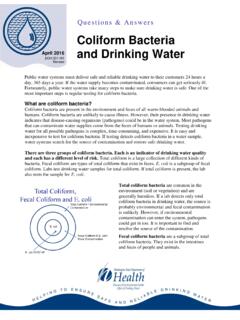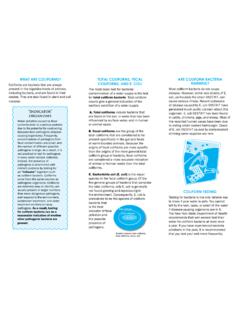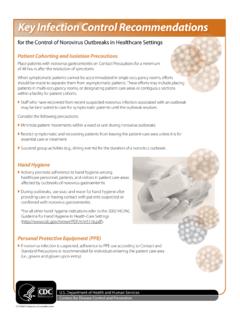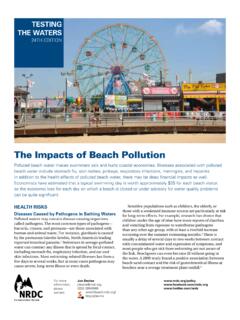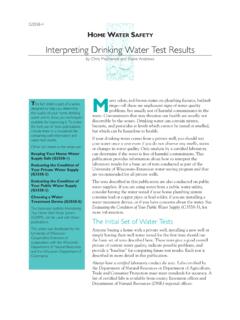Transcription of Excreta-related infections and the role of sanitation in ...
1 2001 World Health Organization (WHO). Water Quality: Guidelines, Standards and Health. Edited byLorna Fewtrell and Jamie Bartram. Published by IWA Publishing, London, UK. ISBN: 1 900222 28 05 Excreta-related infections and therole of sanitation in the control oftransmissionRichard Carr1 This chapter examines the role sanitation (in its widest sense) plays inpreventing the transmission of Excreta-related diseases. The proper managementof excreta acts as the primary barrier to prevent the spread of pathogens in theenvironment. It, thus, directly impacts disease transmission through person-to-person contact, water and the food chain. This chapter focuses on the healthdimensions and relative importance of sanitation measures, and discussestechnical options for the containment and treatment of excreta.
2 It highlights theneed to consider water-related guidelines and standards in terms of the greaterpicture , utilising an integrated approach rather than proceeding on a case bycase basis. 1 With contributions from Martin Strauss90 Water Quality: Guidelines, Standards and INTRODUCTIONH uman excreta and the lack of adequate personal and domestic hygiene havebeen implicated in the transmission of many infectious diseases includingcholera, typhoid, hepatitis, polio, cryptosporidiosis, ascariasis, andschistosomiasis. The World Health Organization (WHO) estimates that people die annually from diarrhoeal diseases and that 10% of thepopulation of the developing world are severely infected with intestinal wormsrelated to improper waste and excreta management (Murray and Lopez 1996;WHO 2000a).
3 Human excreta-transmitted diseases predominantly affectchildren and the poor. Most of the deaths due to diarrhoea occur in children andin developing countries (WHO 1999).Proper excreta disposal and minimum levels of personal and domestichygiene are essential for protecting public health. Safe excreta disposal andhandling act as the primary barrier for preventing excreted pathogens fromentering the environment. Once pathogens have been introduced into theenvironment they can be transmitted via either the mouth ( through drinkingcontaminated water or eating contaminated vegetables/food) or the skin (as inthe case of the hookworms and schistosomes), although in many cases adequatepersonal and domestic hygiene can reduce such transmission. Excreta andwastewater generally contain high concentrations of excreted pathogens,especially in countries where diarrhoeal diseases and intestinal parasites areparticularly prevalent.
4 Therefore for maximum health protection, it is importantto treat and contain human excreta as close to the source as possible before itgets introduced into the the principal focus of the guideline documents examined in thisbook is water, in many settings other disease transmission pathways are at leastas important. In microbiological terms, the traditional approach of examiningeach guideline area in isolation ignores the inter-related pathways and also theroot of the problem, namely excreta and inadequate TRANSMISSION ROUTESH uman excreta may contain many types of pathogens. When these pathogensare introduced into the environment some can remain infectious for long periodsof time (Table ) and, under certain conditions, they may be able to replicatein the environment. The presence of pathogens presents a potential threat tohuman health.
5 However, for an actual risk of disease an infectious dose of theexcreted pathogen must reach a human infections and the role of sanitation91 Table Pathogen and indicator survival in different environmental mediaPathogen survival(time in days unless otherwise indicated)OrganismFreshwaterSaltwaterSoi lCropsViruses11 30411 8716 25 Salmonellae<10<1015 1005 50 Cholera30+285<20<5 Faecal coliforms<10<6<100<50 Protozoan cysts1761yr+75 NDAscaris *2*1 2 yr<60 Tapeworm eggs63*168*7 months<60 Trematodes30-180<2<1*130**ND No data; * Not considered an important transmission pathway; ** AquaticmacrophytesSources: Feachem et al. 1983; Mara and Cairncross 1989; National Research Council1998; Robertson et al. 1992; Rose and Slifko 1999; Schwartzbrod 2000; Tamburrini andPozio : Differing survival times for each organism (or group of organisms) may be relatedto transmission is determined by several pathogen-related factorsincluding: An organism s ability to survive or multiply in the environment(some pathogens require the presence of specific intermediate hoststo complete their lifecycles).
6 Latent periods (many pathogens are immediately infectious, othersmay require a period of time before they become infective). An organism s ability to infect the host (some pathogens can causeinfections when present in small numbers Ascaris, others mayrequire a million or more organisms to cause infection; Feachem etal. 1983).Disease transmission is also affected by host characteristics and behaviour,including: immunity (natural or as a result of prior infection or vaccination) nutritional status health status age sex personal hygiene food Quality: Guidelines, Standards and HealthIn general, pathogenic micro-organisms may be transmitted from source to newvictim in a number of ways including direct person-to-person spread and indirectroutes including inanimate objects (fomites), food, water or insect details a selection of faecal-oral pathogens and their transmissionroutes.
7 As the table shows, multiple transmission routes are the norm, ratherthan the exception, for many pathogenic Selected faecal-oral pathogens and selected transmission routes (adapted fromAdams and Moss 1995)PathogenImportantreservoir/carrierT ransmissionX infoodwaterfoodp-to-pCampylobacter jejuniVariety of animals++++Enterotoxigenic E. coliMan++++Enteropathogenic E. coliMan++++Enteroinvasive E. coliMan++Ni+Enterohaemorrhagic E. coliMan++++Salmonella typhiMan++ +Salmonella (non-typhi)Man and animals + +ShigellaMan++++Vibrio cholerae O1 Man, marine life?++ +Vibrio cholerae, non O1 Man and animals++ Hepatitis AMan+++ Norwalk agentsMan++Ni RotavirusMan+ni+ Cryptosporidium parvumMan, animals+++ Entamoeba histolyticaMan+++ Giardia lambliaMan, animals+ + Ascaris lumbricoidesMan + X in food - multiplication in food p-to-p person-to-person+ yes rare - noni - no informationFigure outlines the routes of transmission, important pathogen and host-related transmission factors and also possible barriers to transmission for excretedpathogens.
8 As Figure illustrates, sanitation is the primary barrier for preventingfaecal-oral disease transmission. If excreta disposal is ineffective or non-existent (orother animals serve as sources of excreted pathogens) other measures must be takento avoid disease transmission. Removing or destroying infectious agents bydisinfecting drinking water prior to consumption or preparation of food; cleaninghands, utensils, and surfaces before food preparation and consumption; and cookingfood thoroughly are interventions that will reduce disease transmission (WHO1993). For example, the simple act of washing one s hands with soap can reducediarrhoea by a third (WHO 2000a). Excreta-related infections and the role of sanitation93 Figure Faecal-oral pathogen transmission contaminated water, both marine and fresh, is a frequent cause offood-borne illness.
9 For example, some shellfish (such as mussels, oysters, andclams) obtain their food by filtering large quantities of water and are thereforeparticularly likely to accumulate contamination . Excreta-related humanpathogens, heavy metals and other chemical contaminants are taken in with thefood particles and can be concentrated in the tissues. Shellfish are alsofrequently eaten raw or partially cooked. Fish, and non-filter feeding shellfish(crabs, lobsters, prawns, shrimps) grown in faecally contaminated watercontaining high levels of human pathogens can also concentrate pathogens intheir intestinal tracts and on their skin surfaces. When concentrations of faecallyderived bacteria exceed a certain level they can be found in muscle tissues(WHO 1989). Infection may occur when the contaminated fish is consumed rawor lightly cooked.
10 Food handlers may also be at risk during preparation of thecontaminated untreated or inadequately treated wastewater or excreta (faecal sludge)is applied to soil and crops, disease transmission can occur. The persons at riskare the farmers, farm workers and their families as well as consumers of crops94 Water Quality: Guidelines, Standards and Healthproduced in such a way. The use of inadequately treated wastewater inirrigation and of faecal sludges in soil amendment and fertilisation is especiallyassociated with elevated prevalence of intestinal helminth infection. Forexample, in a study in Mexico, irrigation with untreated or partially treatedwastewater was directly responsible for 80% of all Ascaris infections and 30%of diarrhoeal disease in farm workers and their families (Cifuentes et al.)










